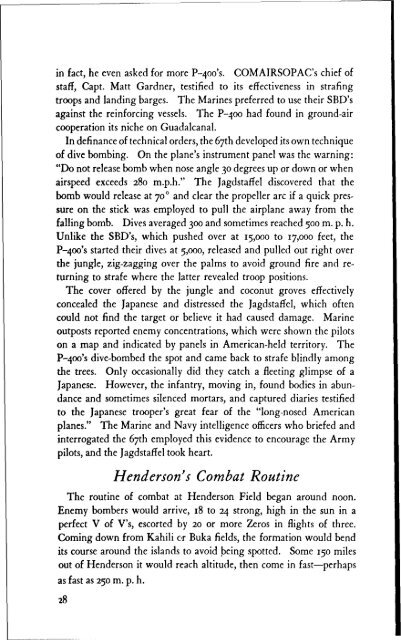Pacific Counterblow - Air Force Historical Studies Office
Pacific Counterblow - Air Force Historical Studies Office
Pacific Counterblow - Air Force Historical Studies Office
Create successful ePaper yourself
Turn your PDF publications into a flip-book with our unique Google optimized e-Paper software.
in fact, he even asked for more P-4oo's. COMAIRSOPAC's chief of<br />
staff, Capt. Matt Gardner, testified to its effectiveness in strafing<br />
troops and landing barges. The Marines preferred to use their SBD's<br />
against the reinforcing vessels. The P-4oo had found in ground-air<br />
cooperation its niche on Guadalcanal.<br />
In definance of technical orders, the 67th developed its own technique<br />
of dive bombing. On the plane's instrument panel was the warning:<br />
"Do not release bomb when nose angle 3o degrees up or down or when<br />
airspeed exceeds 280 m.p.h." The Jagdstaffel discovered that the<br />
bomb would release at 70' and clear the propeller arc if a quick pressure<br />
on the stick was employed to pull the airplane away from the<br />
falling bomb. Dives averaged 3oo and sometimes reached 500 m. p. h.<br />
Unlike the SBD's, which pushed over at 15,000 to 17,000 feet, the<br />
P-4oo's started their dives at 5,ooo, released and pulled out right over<br />
the jungle, zig-zagging over the palms to avoid ground fire and returning<br />
to strafe where the latter revealed troop positions.<br />
The cover offered by the jungle and coconut groves effectively<br />
concealed the Japanese and distressed the Jagdstaffel, which often<br />
could not find the target or believe it had caused damage. Marine<br />
outposts reported enemy concentrations, which were shown the pilots<br />
on a map and indicated by panels in American-held territory. The<br />
P-4oo's dive-bombed the spot and came back to strafe blindly among<br />
the trees. Only occasionally did they catch a fleeting glimpse of a<br />
Japanese. However, the infantry, moving in, found bodies in abundance<br />
and sometimes silenced mortars, and captured diaries testified<br />
to the Japanese trooper's great fear of the "long-nosed American<br />
planes." The Marine and Navy intelligence officers who briefed and<br />
interrogated the 67th employed this evidence to encourage the Army<br />
pilots, and the Jagdstaffel took heart.<br />
Henderson's Combat Routine<br />
The routine of combat at Henderson Field began around noon.<br />
Enemy bombers would arrive, 18 to 24 strong, high in the sun in a<br />
perfect V of V's, escorted by 20 or more Zeros in flights of three.<br />
Coming down from Kahili cr Buka fields, the formation would bend<br />
its course around the islands to avoid being spotted. Some 150 miles<br />
out of Henderson it would reach altitude, then come in fast-perhaps<br />
as fast as 250 m. p. h.<br />
28
















